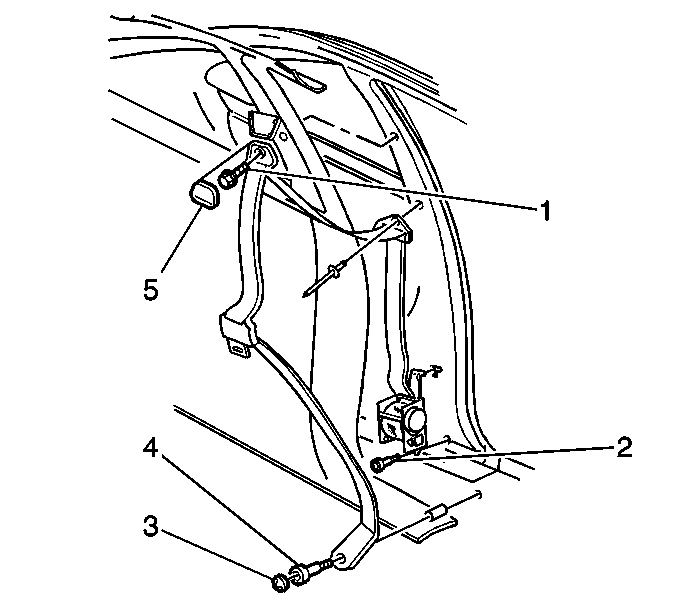Seat Belt Retractor Replacement - Left Front Sedan
Removal Procedure
- Remove the plug for seat belt anchor bolt.
- Remove the seat belt anchor bolt.
- Lift up on the bottom edge of the shoulder belt guide cover .
- Remove the shoulder belt guide bolt.
- Remove the carpet retainer. Refer to Carpet Retainer Replacement in Interior Trim.
- Remove the seat belt retractor bolt.
- Pull upward on the seat belt retractor.



This will disengage the retractor from the T-slot in the center pillar.
Installation Procedure
Important: Remove any twists in the seat belt webbing before final assembly.
- Insert the top of the seat belt retractor into the T-slot.
- Install the seat belt retractor bolt.
- Install the left carpet retainer. Refer to Carpet Retainer Replacement in Interior Trim.
- Install the shoulder belt guide bolt.
- Push down on the shoulder belt guide cover until fully seated.
- Install the seat belt anchor bolt.
- Install the seat belt sleeve anchor plug.
- Inspect left front seat belt retractor for proper operation. Refer to Operational and Functional Checks .

Push down the top of the retractor to engage the retractor with the T-slot in the center pillar.
Notice: Use the correct fastener in the correct location. Replacement fasteners must be the correct part number for that application. Fasteners requiring replacement or fasteners requiring the use of thread locking compound or sealant are identified in the service procedure. Do not use paints, lubricants, or corrosion inhibitors on fasteners or fastener joint surfaces unless specified. These coatings affect fastener torque and joint clamping force and may damage the fastener. Use the correct tightening sequence and specifications when installing fasteners in order to avoid damage to parts and systems.
Tighten
Tighten the bolt to 42 N·m (31 lb ft).

Tighten
Tighten the bolt to 28 N·m (21 lb ft).

Tighten
Tighten the bolt to 42 N·m (31 lb ft).
Seat Belt Retractor Replacement - Left Front Coupe
Removal Procedure
- Remove the seat belt anchor plug (3).
- Remove the seat belt anchor bolt (4).
- Lift up on the bottom edge of the shoulder belt guide cover (5).
- Remove the shoulder belt guide bolt (1).
- Remove the rear quarter trim panel. Refer to Rear Quarter Trim Panel Replacement in Interior Trim.
- Remove the seat belt intermediate guide rivet.
- Remove the seat belt retractor bolt (2).
- Pull upward on the seat belt retractor.

This will disengage the retractor from the T-slot in the center pillar.
Installation Procedure
Important: Remove any twists in the seat belt webbing before final assembly.
- Insert the top of the seat belt retractor into the T-slot.
- Install the seat belt retractor bolt (2).
- Install the seat belt intermediate guide rivet.
- Install the rear quarter trim panel. Refer to Rear Quarter Trim Panel Replacement in Interior Trim.
- Install the shoulder belt pillar bolt (1).
- Push down on the shoulder belt guide cover (5) until fully seated.
- Install the seat belt anchor bolt (4).
- Install the seat belt anchor bolt plug (3).
- Inspect the seat belt retractor for proper operation. Refer to Operational and Functional Checks .

Push down the top of the retractor to engage the retractor with the T-slot in the center pillar.
Notice: Use the correct fastener in the correct location. Replacement fasteners must be the correct part number for that application. Fasteners requiring replacement or fasteners requiring the use of thread locking compound or sealant are identified in the service procedure. Do not use paints, lubricants, or corrosion inhibitors on fasteners or fastener joint surfaces unless specified. These coatings affect fastener torque and joint clamping force and may damage the fastener. Use the correct tightening sequence and specifications when installing fasteners in order to avoid damage to parts and systems.
Tighten
Tighten the bolt to 42 N·m (31 lb ft).
Tighten
Tighten the bolt to 28 N·m (21 lb ft).
Tighten
Tighten the bolt to 42 N·m (31 lb ft).
